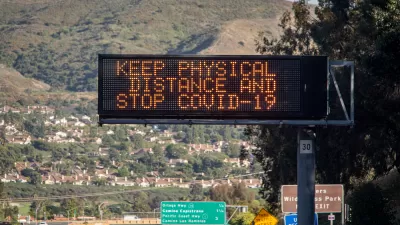Many think the two geographic divisions in CA are north and south, but this article uses economic data to show that the real division is between coastal and inland. These differences transcend economics and are revealed in public policies as well.
While the Inland Empire and the Central Valley were the fastest growing regions of the state in the last decade, that exurban growth has slowed to a halt.
Based in San Bernardino in what is known as the Inland Empire (along with Riverside County), Jennifer Medina provides insight into the vast economic differences between west and east. The region "posted an unemployment rate of 12.6 percent in March. Compared with Orange County, on the more prosperous, western side of California's vertical divide with an unemployment rate of 8 percent, it can feel like another world.... El Centro, on the state's southeast edge, has the highest unemployment rate for any metropolitan area in the country, nearly 27 percent."
Growth based on housing alone is unsustainable.
"While suburbs in the eastern parts of the state were some of the fastest-growing areas in the nation in the last decade, that growth has slowed to a near halt. Hans Johnson, a researcher with the Public Policy Institute of California, explains that "people were just following the building of roofs, so what you end up with in a bust, areas that were dependent on growth suffer tremendously when it dries up."
Stephen Levy, the director of the Center for Continuing Study of the California Economy adds that "places that existed just for housing are not going to come back anytime soon."
Transcending Economics
"The differences between the west and east are not limited to the economy; several studies have shown that the coastal areas are more politically liberal than their inland counterparts. New environmental laws, for example, may be embraced in cities focused on preserving the beach, but viewed as anathema to some inland political leaders who see regulations as a path to driving businesses out of the state."
FULL STORY: In California, Economic Gap of East vs. West

Study: Maui’s Plan to Convert Vacation Rentals to Long-Term Housing Could Cause Nearly $1 Billion Economic Loss
The plan would reduce visitor accommodation by 25,% resulting in 1,900 jobs lost.

North Texas Transit Leaders Tout Benefits of TOD for Growing Region
At a summit focused on transit-oriented development, policymakers discussed how North Texas’ expanded light rail system can serve as a tool for economic growth.

Why Should We Subsidize Public Transportation?
Many public transit agencies face financial stress due to rising costs, declining fare revenue, and declining subsidies. Transit advocates must provide a strong business case for increasing public transit funding.

How to Make US Trains Faster
Changes to boarding platforms and a switch to electric trains could improve U.S. passenger rail service without the added cost of high-speed rail.

Columbia’s Revitalized ‘Loop’ Is a Hub for Local Entrepreneurs
A focus on small businesses is helping a commercial corridor in Columbia, Missouri thrive.

Invasive Insect Threatens Minnesota’s Ash Forests
The Emerald Ash Borer is a rapidly spreading invasive pest threatening Minnesota’s ash trees, and homeowners are encouraged to plant diverse replacement species, avoid moving ash firewood, and monitor for signs of infestation.
Urban Design for Planners 1: Software Tools
This six-course series explores essential urban design concepts using open source software and equips planners with the tools they need to participate fully in the urban design process.
Planning for Universal Design
Learn the tools for implementing Universal Design in planning regulations.
City of Santa Clarita
Ascent Environmental
Institute for Housing and Urban Development Studies (IHS)
City of Grandview
Harvard GSD Executive Education
Toledo-Lucas County Plan Commissions
Salt Lake City
NYU Wagner Graduate School of Public Service




























